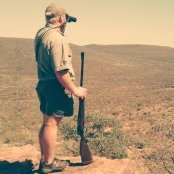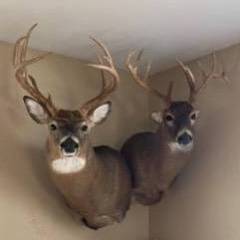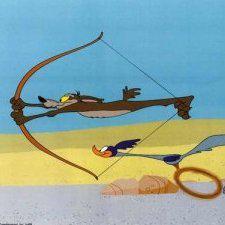African Hunter
-
Similar Content
-
By TheHornHunter
I put up another post a few days ago about the buck I harvested and the favorable weather setup I took advantage of. A member replied asking me to expand on this and how barometric pressure impacts deer movement so I decided to make a new post about it.
Cold fronts are one of the best catalysts for deer movement and there are three phases to any cold front which we will discuss later as it relates to hunting. I’ve generalized the wind conditions below which are based on our typical north westerly winds for cold fronts but we occasionally have a NE system come through:
Just before: winds will typically shift NW to N and barometric pressure will start increasing as temps slowly start to drop During: winds typically still NW to N, barometric pressure is high (30.2+) but typically flattens out as temperatures bottom After: winds shift S to SW, barometric pressure starts dropping as temps increase Before we get to the hunting part I think it’s worth explaining why cold fronts impact deer movement and how the deer react and interpret the weather conditions. Cold weather causes deer to use more energy to sustain which means they need to eat more and thus must head to food more during day light. During the rut it also drives more movement because it’s more favorable for bucks to run around – think about working out on a 90 degree July day vs. a 60 degree September day; I bet you can do a lot more and be more comfortable in September than July. So how do deer react to a cold front? Deer can sense changes in barometric pressure - I believe through a sensor in their ear - and they know if it starts rising that probably means colder weather is coming and vice versa when it drops. This means you’ll see movement just before it hits because deer will sense the pressure rising and will hit the feed to try and get enough reserves to get through whatever is coming. Once the cold is here and pressure is high they will typically continue to feed heavy or if during rut running around like crazy (partly because does are out more trying to eat). Finally, once the pressure starts dropping deer will understand better conditions are coming which I find usually has one good day of movement where deer are out restocking feed reserves and getting their social fix; after the first day of warmer temps I find movement drops off pretty drastically.
Now to the fun part – how do you hunt them? Most of you know how powerful a October or early-to-mid November cold front can be at getting deer – especially mature bucks – up on their feet and I think any one of the above phases is a good time to be in the woods, although I’ve seen the most movement in #2 when temps are the lowest followed by #1 just before it hits and deer are preparing for it.
That all changes from my experience once we get past the middle of November - they are still just as powerful (if not more) at driving movement but require different tactics. The cold fronts are now much colder with typically higher wind speeds and the deer are much more run down from already going through the bulk of rut. This translates to much more movement on phase #1 when the first northerly winds come in and pressure starts rising (signaling to deer bad weather ahead and the need to feed) and phase #3 when wind switches out of the south, temps start rising and pressure starts falling (signaling to deer the coast is clear and better conditions ahead). I’ve spent many lonely cold hours in the stand during the middle of those cold fronts thinking deer would be out feeding hard when temps are the lowest but based on my observations they more so just hunker down in thermal bedding and forage on whatever is close to that. It’s almost like they avoid movement to try and conserve as much food reserves as they can which makes sense given the difference in temps (an October / early November cold front probably bottoms out at 20-40F while later season they will usually be single digits). I think the very low movement characteristics of phase #2 really enhance phase #3 which is by far my favorite time to hunt one of these cold fronts - phase #1 is good too and I definitely go out but I generally stay out of woods during phase #2 and do stuff like pull trail cam cards, put up new sets, etc. Deer are social creatures and become more like humans late season in that they don’t like nasty weather any more than us. Deer will crave social interaction after being bottled up for a couple days dealing with extreme cold so there’s two powerful factors driving movement in phase #3 (need to restore feed reserves and get their social fix). If you get one of these cold fronts from say 11/15 to 11/25 then you add another even more powerful factor and that’s the desire to breed with the tail end of rut. Bucks will finish breeding any does they are locked down with during the cold front but they don’t really go out seeking new ones until weather gets better so you can see some powerful seeking and chasing on the first south wind after a cold front (especially with mature bucks).
This is exactly what happened on my hunt – Tuesday afternoon the winds shifted NW and pressure started rising so I jumped in an observation stand overlooking a creek bed and rye grass field on one of my properties and saw quite a few does and some bucks (including a big frame 10) hitting the tallest section of grass an hour before sunset. Temps dropped to single digits Wednesday and Thursday – I ended up hunting Thursday because it was thanksgiving and who doesn’t hunt on Thanksgiving (?!) but only saw a few does – I usually see at least one 3 year old buck and minimum of 10-15 deer every time I hunt this property so this was a very slow day. Friday AM was still very cold but winds switched to the south, pressure started dropping, and it was probably 35 degrees by 2PM when I headed out. I went to the closest spot I could get to where I saw the deer feeding in the rye on Tuesday which happened to be in a hedgerow – we didn’t have a stand on it so I put some brush together and made a DIY blind to ground hunt from. I had a 3 year 130-140 class 8 pointer cruise by within 60 yards of me less than ten minutes after I was set up and had constant action the rest of the evening (two mature bucks, two 3 year olds, three 2 year olds and ~15 small bucks and does). I had 8 does in front of me in the rye around 430PM when I saw one snap her head back to the creek bed at the head of the hedgerow I was on and a second later I had my buck in sight at a full run after her grunting like crazy. I couldn’t stop him and ended up shooting him on the run, but it was something I will never forget and is a good example of how powerful the action can be right after one of those brutal late November cold fronts.
The best stand locations are pinch points between bedding and food or right on a food source (my favorite are green ones like winter wheat, clover, rye, etc. or a cut corn field). I like to sit an observation stand where I can see a lot of ground on the first phase so I can get an idea of where the deer are moving and then I move in on those spots and either ground hunt or do a hang and hunt on that first day of southerly winds (unless of course I’m lucky enough to already have a set hung there but I’m usually not that lucky).
I hope this helps explain my strategy better and helps one of you put a nice buck on the ground! Definitely let me know if anyone has any questions or has different opinions or experience on the matter.
--- Horn Hunter
-
By ryno botma
Hi guys new member here from South Africa.
My name is Ryno Botma I'm a professional hunter and ranch manager in south Africa.
Along with Kwalata safaris we hunt all over southern Africa and Mozambique , we are just trying to expand our horizons and get our name out there .
Pleas feel free to ask any questions and have a look at our website www.kwalatasafaris.co.za
You can also watch our promotional video with the link below
Please feel free to send me a mail regarding our specials for 2018 [email protected]
[email protected]
Best regards
Ryno
-
-
Recently Browsing 0 members
No registered users viewing this page.






Recommended Posts
Join the conversation
You can post now and register later. If you have an account, sign in now to post with your account.